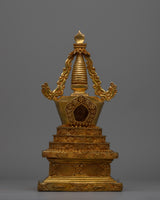
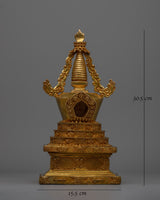
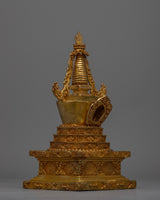
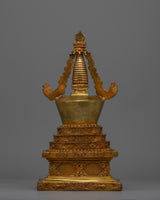
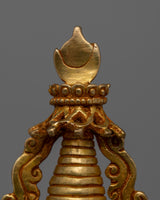
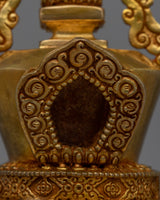
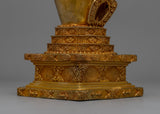
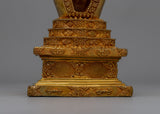
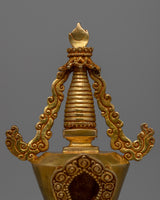
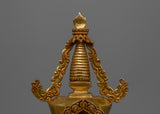
Tibetan Gold-Plated Stupa | Masterpiece of Sacred Buddhist Art

100% AUTHENTIC

HANDMADE

FREE SHIPPING
Tibetan Gold-Plated Stupa | Symbol of Protection
About Our Stupa :
This Buddhist Altar Stupa, built from copper and gold-plated, a representation of the Buddha's enlightened wisdom. Gold, in Buddhist iconography, symbolizes divinity, purity, and sacred energy, it is noted for its spiritual meaning and complex design. The stupa, expertly carved by Nepali artisans, incorporates beautiful Buddhist artwork that embodies the teachings and holy geometry connected with Buddhist stupas. The craftsmanship represents the stupa's profound veneration and cultural significance in Buddhist practice, making it an important complement to any altar or sacred location.
The base of the stupa consists of several layers, each adorned with meticulously detailed patterns. The repeating motifs reflect the spiritual ascent from the physical world to higher states of consciousness.
The central portion of the stupa features an ornate design, with intricate carvings framing a niche. This niche could symbolize an area where sacred relics or offerings may be housed, an essential aspect of stupa significance in Tibetan tradition.
With a height of 30.5 cm, a width of 15.5 cm, and a weight of 3.03 kg, this stupa is both a decorative and spiritual centerpiece. Its substantial structure and intricate design encourage concentration and reflection, representing the path to enlightenment and inner serenity. This stupa, with its rich detailing and symbolism, is not only a beautiful work of art but also a profound reminder of the Buddhist journey towards wisdom and inner peace.
Introduction To Stupa :
Before Buddhism, great teachers were buried in mounds. Some were cremated but sometimes buried in a seated, meditative position. The mound of earth covered them up. Thus, the domed shape of the stupa came to represent a person seated in meditation, much as the Buddha was when he achieved Enlightenment and knowledge of the Four Noble Truths. The stupa's base represents his crossed legs as he sat meditatively. The middle portion is the Buddha’s body and the top of the mound, where a pole rises from the apex surrounded by a small fence, represents his head. Before images of the human Buddha were created, reliefs often depicted practitioners demonstrating devotion to a stupa.
-----------------------------------------
Size: 30.5cm(Height) x 15.5cm(Width)
Weight: 3.03 kg
Materials: Copper body, Gold Plating
-----------------------------------------
How to set up your own Buddhist Shrine?
-Find a clean, quiet, and uncluttered spot.
-Set up an altar table, and cover it with an altar cloth that calls to you
-Place your sacred item (statue, thangka, or a picture of Buddha) at the center
------------------------------------------------------------------




















